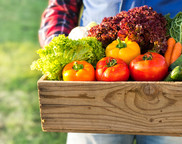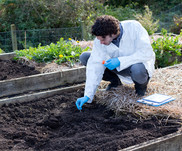|
Having trouble viewing this email? View it as a Web page.

|
|
|
Editor: Kelly Sprute Feb. 26, 2020
Making a Difference

Feed Supplement for Dairy Cows Cuts Their Methane Emissions
The addition of 3-Nitrooxypropanol to the feed of dairy cows reduced their enteric methane emissions by about 25 percent in a recently published study — one in a series of Penn State University studies of the investigational substance in the United States — which might be an early step toward it being approved for use in this country. Often referred to as 3-NOP, the compound inhibits an enzyme that is crucial to the final stage of methane synthesis in a cow’s rumen. When 3-NOP is fed to cattle, their methane production is inhibited. The National Institute of Food and Agriculture helped support this work. Read the full Penn State University article.
3-Nitrooxypropanol inhibits an enzyme that is crucial to the final stage of methane synthesis in a cow’s rumen. When this compound is fed to cattle, their methane production is inhibited. Image courtesy of DSM.
|
|
|

In case you missed it, late last week, Secretary Perdue announced USDA’s new Agriculture Innovation Agenda, a department-wide initiative to align resources, programs, and research to position American agriculture to better meet future global demands. Specifically, USDA will stimulate innovation so that American agriculture can achieve the goal of increasing production by 40 percent while cutting the environmental footprint of U.S. agriculture in half by 2050. For more information, read the full USDA press release. Additionally, yesterday’s USDA blog was focused on NIFA’s Contributions to America’s Agriculture Research and Innovation.
|

NIFA’s Contribution to America’s Agriculture Research and Innovation
National Innovation Day was February 16th this year. The National Institute of Food and Agriculture (NIFA) directly contributes to America’s agriculture research and innovation, ultimately benefiting our farmers, ranchers, and foresters. Through an integrated approach of research, education, and Cooperative Extension (extension) – and strong collaboration with our grantees, partners, stakeholders, other Federal agencies, and Congress – NIFA ensures that groundbreaking discoveries in agriculture-related sciences and technologies reach the people who can put them into practice. Most of NIFA’s programs contribute to America’s agricultural research and innovation, including NIFA’s flagship competitive grants program, the Agriculture and Food Research Initiative (AFRI), and the Small Business Innovation Research (SBIR) grant program.
Secretary Sonny Perdue launches the USDA Agriculture Innovation Agenda to align research and programs between the public and private sectors.
|

Rural Emergency Personnel, Unique Response and Training
While training and education for firefighters and emergency response personnel is standard, rural first responders must at times face unique incidents, and adopt unique procedures. USDA’s Rod Bain looks at rural emergency response, and how it differs from urban and suburban emergencies, in this edition of "Agriculture USA". Rod talks with Scott Heiberger of the National Farm Medicine Center and Kevin Zummwalt of the University of Missouri's Fire and Rescue Training Institute about rural emergency personnel. Listen to the USDA broadcast.
|

Diet Alone Can Improve Older Adults’ Health
Older adults on a diet designed to help patients with high blood pressure reaped benefits beyond those anticipated by South Dakota State University (SDSU) researchers. Assistant professor Cydne Perry of the Department of Health and Nutritional Sciences sought to evaluate whether adults age 65 and older on the Dietary Approaches to Stop Hypertension diet, or DASH, with a prescribed protein intake would maintain muscle mass and strength. "Muscle maintenance is a way to reduce older adults' risk of falling, thus improving their quality of life while reducing health-care costs," Perry explained. Read the full SDSU article.
The project is partially supported by the USDA’s National Institute of Food and Agriculture funding through the South Dakota Agricultural Experiment Station.
|

Nutrition Incentive Program Video
Mas Fresco, More Fresh & Market Match developed the Nutrition Incentive Program video in conjunction with the Ecology Center to share information with SNAP recipients and SNAP eligible community members across California about the opportunity to participate in the Market Match and the Mas Fresco More Fresh Nutrition Incentive Programs. The Nutrition Incentive Program video is part of their GusNIP Marketing and Outreach efforts. Watch the video.
Fresh food image courtesy of Getty Images.
|

Healthy Soils Lead to Healthy Food and Added Value for All
It’s been said that America has the most plentiful, safe and nutritious food supply in the world. In 2018, the U.S. Department of Agriculture’s Economic Research Service (ERS) reported that 89.9 percent of U.S. households were food secure throughout the year, with 11.1 percent of households reporting some food insecurity at least some time during the year, an improvement over the prior year.
With our vast natural resources and our breadth of food and agriculture research, American farmers can grow enough to feed our own nation and many others. And yet, there is a slow rumbling in some circles that today’s food is less “nutrient-dense” than the food our grandmothers and great-grandmothers once put on their tables. Nutrient density, however, considers the health of the soils that are producing the crops. Read the full High Plains Journal article.
Carrying out a soil analysis. Image courtesy of Getty Images.
|
NIFA invests $384,000 to promote Women and Minorities in STEM Education
NIFA recently announced four awards to support research and extension projects that engage women and underrepresented minorities from rural areas in science, technology, engineering, and mathematics (STEM). NIFA’s Women and Minorities in Science, Technology, Engineering, and Mathematics Fields Program (WAMS) improve the economic health and viability of rural communities by developing research and extension initiatives that focus on new and emerging employment opportunities in STEM occupations.
NIFA invests $3 million to support Alaska Native-Serving and Native-Hawaiian Institutions
NIFA recently announced four awards to promote and strengthen the ability of Alaska Native-Serving Institutions and Native Hawaiian-Serving Institutions to carry out education, applied research, and related community development programs. The NIFA Alaska Native-Serving and Native Hawaiian-Serving Institutions Education Competitive Grants Program gives priority to those projects that enhance educational equity for underrepresented students; strengthen institutional educational capacities; prepare students for careers related to the food, agricultural, and natural resource systems of the United States; and maximize the development and use of resources to improve food and agricultural sciences teaching programs.

Food Safety Outreach Program
The Food Safety Outreach Program complements and expand the national infrastructure of the National Food Safety Training, Education, Extension, Outreach, and Technical Assistance Competitive Grants Program. Food Safety Outreach builds upon that national infrastructure, with a sustained focus on delivery of customized training to the target audiences. Awardees will develop and implement food safety training, education, extension, outreach and technical assistance projects that address the needs of owners and operators of small to mid-sized farms, beginning farmers, socially-disadvantaged farmers, small processors, or small fresh fruit and vegetable merchant wholesalers. Grant applications will be solicited directly from those in local communities to include those from community-based organizations, non-governmental organizations, food hubs, farm cooperatives, extension, and other local groups. For more information read the full Food Safety Outreach request for funding application.
|
|
|
|
NIFA’s mission is to invest in and advance agricultural research, education, and extension that solve societal challenges. NIFA’s investments in transformative science directly support the long-term prosperity and global preeminence of U.S. agriculture. Keep informed about NIFA, USDA, our land-grant and non-land-grant university partners, and stakeholders with the NIFA Update. Read past issues online, sign up for email updates or follow us on Twitter @USDA_NIFA, #NIFAImpacts or LinkedIn @usda-nifa.
If you wish to submit a news item or information, send an email to NIFAUpdate.
USDA is an equal opportunity lender, provider, and employer.
|
|
|
|